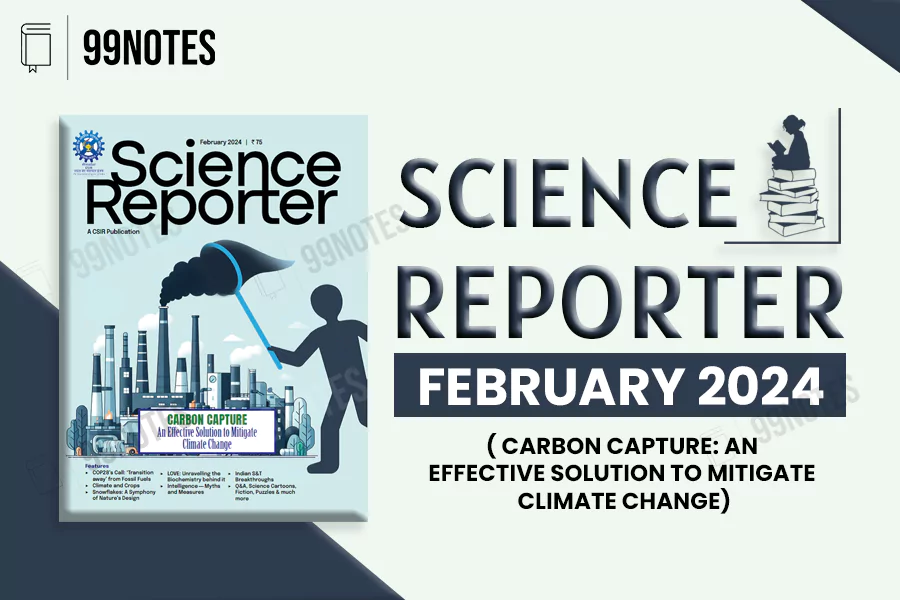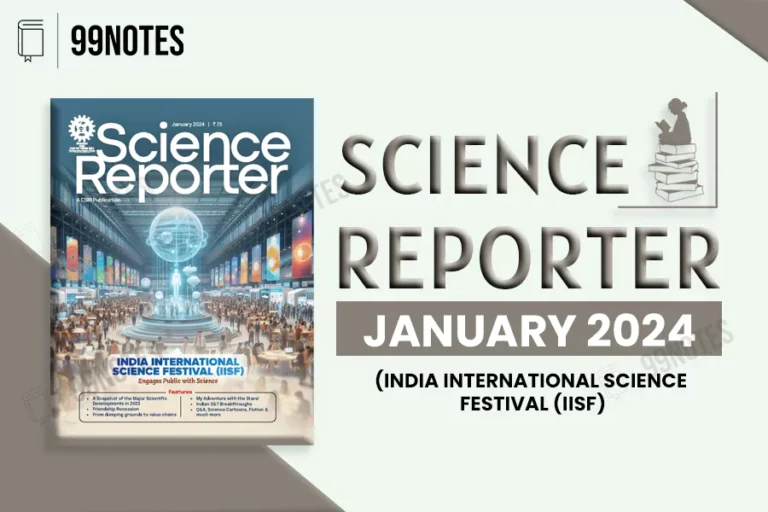Science Reporter Summary February 2024
Science Reporter Magazine Summary February 2024
In the February 2024 edition of Science Reporter summary, brought to you by 99notes, we bring you exciting scientific developments from around the globe. This issue features stories on India’s successful solar mission with Aditya-L1, groundbreaking research at IISER Bhopal on neutralizing chemical warfare agents, and insights into how the human brain learns compared to AI systems. We also explore the health risks associated with invasive species in India, discuss the advancements in carbon capture technologies, and reflects on global initiatives to mitigate climate change at COP 28. Each article highlights significant scientific efforts and discoveries that contribute to our understanding and improvement of the world around us.
Article 1: ISRO’s Aditya-L1 Reaches its Destination
India’s Success in Space Science: Aditya-L1 Mission

- At the dawn of 2024, India celebrates a significant achievement in space exploration with the successful placement of the solar spacecraft Aditya-L1 into a Halo orbit around Sun-Earth Lagrangian point 1 (L1) on January 6, 2024.
- Named after the Hindu Sun god ‘Aditya’, this mission marks India’s inaugural endeavour towards studying the Sun and places the country among the elite in solar research.
- This milestone follows closely after the triumphant landing of Chandrayaan-3 on the Moon’s south pole in August 2023, positioning India as the first nation to accomplish such a feat.
Mission Objectives and Launch
- The Indian Space Research Organisation (ISRO) initiated the Aditya-L1 mission to observe and comprehend the chromospheric and coronal dynamics of the Sun.
- Launched aboard the Polar Satellite Launch Vehicle (PSLV-C57) from the Satish Dhawan Space Centre (SDSC) on September 2, 2023, the spacecraft successfully reached its destination at the Halo orbit around L1, approximately 1.5 million kilometres from Earth.
- This strategic placement enables uninterrupted real-time observation of solar activities, which is crucial for understanding space weather conditions and their impact on Earth and beyond.
Significance of Sun Observation
- Given the Sun’s pivotal role in our solar system, serving as the primary source of energy and influencing various terrestrial phenomena, studying its dynamics is paramount.
- Aditya-L1’s mission equips researchers worldwide with invaluable insights into solar processes, aiding in comprehending space weather’s effects on communication systems, power grids, and satellite operations.
- By studying phenomena like Coronal Mass Ejections (CMEs) and plasma physics, the mission seeks to unravel the Sun’s mysteries and enhance our understanding of its influence on the broader cosmic environment.
Technological Advancements and Future Implications
- Aditya-L1 is equipped with state-of-the-art instruments, including seven indigenous scientific payloads designed to observe different layers of the Sun.
- This mission exemplifies India’s technological prowess and commitment to advancing scientific knowledge for societal benefit. The tireless efforts of scientists and their teams underscore the precision and dedication invested in executing this complex mission.
- The mission’s achievements are poised to significantly contribute to astrophysics, astronomy, climate studies, and technological innovation, inspiring future generations to pursue scientific exploration and innovation.
Conclusion
- India’s successful placement of the Aditya-L1 spacecraft in orbit around the Sun represents a remarkable feat in space science.
- With its ambitious objectives and cutting-edge technology, this mission advances our understanding of the Sun and paves the way for future discoveries and innovations in space exploration and beyond.
- As India progresses in science and technology, missions like Aditya-L1 serve as beacons of inspiration, propelling humanity towards new frontiers of knowledge and discovery.
ARTICLE 2: IISER Bhopal researchers develop material to break down chemical warfare agents like Mustard Gas
IISER Bhopal’s Breakthrough: Development of a Novel Photocatalyst
- Researchers at the Indian Institute of Science Education and Research, Bhopal (IISER Bhopal), have achieved a significant milestone in sustainable energy technology by developing an innovative photocatalyst.
- This substance, capable of absorbing a broad spectrum of solar energy and light, accelerates chemical processes in laboratories and industries.
- Their research contributes to harnessing renewable energy sources for crucial applications such as detoxifying harmful substances, including chemical warfare agents like mustard gas simulants and nerve agents, which pose severe health risks to humans.
Advancements in Photocatalysis
- The development of this photocatalyst represents a breakthrough in the field of photocatalysis, where substances are used to alter the rate of chemical reactions under light exposure.
- Unlike conventional photocatalysts that only absorb UV or high-energy light, the newly developed material, known as ‘UC-POP-Au,’ exhibits exceptional strength and catalytic efficiency by absorbing the entire light spectrum.
- This characteristic makes it a more potent catalyst for various chemical processes.
Real-world Applications and Technical Details
- Published in the peer-reviewed journal Angewandte Chemie, the research findings highlight the potential applications of UC-POP-Au in designing protective coatings against chemical warfare agents under natural sunlight conditions.
- The composite material integrates near-infrared absorbing upconversion nanoparticles, visible light absorbing gold nanoparticles, and UV rays absorbing conjugated Porous Organic Polymer (POP).
- This unique combination significantly enhances chemical reactions, paving the way for diverse industrial applications.
Reusable and Efficient
- UC-POP-Au performs exceptionally in detoxifying chemical warfare agents, outperforming traditional polymer-based photocatalysts.
- Moreover, it exhibits reusability, maintaining catalytic activity even after multiple uses, unlike other catalysts that degrade over time.
- This reusability aspect enhances the practicality and cost-effectiveness of the photocatalyst in industrial settings.
Future Implications and Further Research
- The potential applications of UC-POP-Au extend beyond chemical warfare agent detoxification.
- The research team envisions its use in creating personal protective equipment and exploring its suitability for various other industrial applications.
- Moving forward, the team at IISER Bhopal aims to expand their research to develop advanced materials for harnessing light energy to break down other toxic chemicals, contributing to sustainable environmental practices and industrial processes.
Conclusion
- The development of UC-POP-Au by researchers at IISER Bhopal represents a significant stride in sustainable energy technology and chemical process acceleration.
- With its broad spectrum light absorption and remarkable catalytic efficiency, this novel photocatalyst holds promise for various industrial applications, including the detoxification of chemical warfare agents.
- As research continues to evolve, the potential for UC-POP-Au to address environmental and industrial challenges remains substantial, underscoring its significance in advancing scientific knowledge and technological innovation.
ARTICLE 3: The way the brain learns is different from and better than the way that Al systems learn
New Principle in Learning Dynamics: Insights from Brain Networks and AI
- Researchers from the MRC Brain Network Dynamics Unit and Oxford University’s Department of Computer Science have introduced a novel principle to elucidate how the brain adjusts connections between neurons during the learning process.
- This breakthrough offers valuable insights into learning dynamics within brain networks and holds promise for enhancing learning algorithms in Artificial Intelligence (AI).
Understanding Learning Processes
- The essence of learning involves identifying the components responsible for errors in output within the information-processing pipeline.
- In AI, this is achieved through backpropagation, which adjusts a model’s parameters to minimize output errors.
- While many believe the brain employs a similar learning principle, it surpasses current machine learning systems’ efficiency and robustness.
Different Learning Principles
- Traditional machine learning systems often require extensive training with repetitive exposure to information, while the human brain can learn new concepts rapidly with minimal repetition.
- Moreover, unlike artificial neural networks, which often degrade existing knowledge during new learning tasks, the brain can acquire new knowledge without interfering with existing information.
Prospective Configuration: A New Learning Principle
- The researchers propose a new learning principle termed ‘prospective configuration,’ which differs fundamentally from traditional artificial neural network learning approaches.
- In the prospective configuration, the brain settles neuronal activity into an optimally balanced state before adjusting synaptic connections.
- This minimizes interference and preserves existing knowledge, thereby accelerating the learning process.
Implications and Applications
- Published in Nature Neuroscience, the study demonstrates through computer simulations that models employing prospective configuration learn faster and more effectively than traditional artificial neural networks.
- Real-life examples, such as a bear fishing for salmon, illustrate how prospective configuration allows the brain to adapt to changing circumstances without compromising existing knowledge.
Conclusion
- Identifying prospective configuration as a fundamental learning principle in the brain offers valuable insights into learning dynamics and potential applications in AI.
- This research enhances our understanding of brain networks and inspires the development of more efficient and robust learning algorithms.
- As efforts continue to bridge the gap between theoretical models and actual brain anatomy, the prospect of integrating prospective configurations into future computing technologies holds immense promise for advancing artificial intelligence and cognitive science.
ARTICLE 4: Invasive Species and its Associated Health Risk Issues in India
Impact of Invasive Alien Species (IAS) on Biodiversity and Health

- IAS have emerged as a significant driver of global biodiversity loss, posing threats to food security and human well-being by devastating agriculture, aquaculture, and ecosystems.
- While researchers and policymakers focus on economic and biodiversity losses caused by IAS, the associated health risks to humans and wildlife are often overlooked.
Mechanisms of Disease Transmission
- IAS typically introduce pathogens and vectors, leading to disease outbreaks in native ecosystems.
- For example, outbreaks of avian malaria in Hawaii were facilitated by the introduction of Plasmodium relictum-infected mosquitoes, with invasive feral pigs exacerbating the problem by creating breeding sites for vectors.
- Additionally, co-introductions of alien species and exotic pathogens significantly increase pathogen diversity, resulting in epidemic diseases in both humans and wildlife.
Historical and Recent Outbreaks
- Historical events like the bubonic plague and recent outbreaks such as Ebola and Zika virus highlight the role of animals in disease transmission to humans.
- Illegal international trade, habitat destruction, and climate change further exacerbate the introduction of pathogens and vectors into new habitats.
Case Studies in India
- In India, invasive species like water hyacinth and parthenium weed contribute to biodiversity loss and pose health risks.
- Water hyacinth proliferation in water bodies creates breeding sites for disease vectors, increasing mosquito-borne diseases.
- Parthenium weed causes severe health disorders in humans and animals, affecting respiratory and gastrointestinal systems.
Impact on Agriculture
- The invasion of Fall Armyworm (FAW) in Indian maize and corn fields has resulted in significant crop losses.
- Infected crops are prone to fungal infections, producing aflatoxins classified as carcinogenic and mutagenic by the European Food Safety Authority.
- Aflatoxins contaminate human and animal food sources, posing health risks.
Need for Action
- Efforts are needed to educate consumers and farmers about the risks associated with infected crops.
- Stringent policies and laws regarding the marketing and disposal of infected produce are essential.
- Additionally, comprehensive screening is required to identify pathogens and vectors associated with invasive species to protect human and wildlife health.
- More research is needed to understand the health risks posed by IAS in India, given the prevalence of over 150 invasive species in the country.
ARTICLE 5: CARBON CAPTURE AN EFFECTIVE SOLUTION TO MITIGATE CLIMATE CHANGE
The Role of Carbon and Carbon Dioxide in Ecological Processes
- Carbon is a fundamental element in all living organisms, forming the basis of various molecules crucial for cellular structure and function.
- Meanwhile, carbon dioxide (CO2) regulates Earth’s climate and supports life through photosynthesis.
- However, human activities have led to elevated CO2 levels, contributing to climate change and its associated impacts.
Carbon Capture Technologies: Addressing Climate Change

- Carbon capture technologies offer a promising approach to mitigate CO2 emissions and combat climate change.
- These technologies capture CO2 from point sources like power plants and industrial facilities before it is released into the atmosphere.
- Carbon capture helps reduce greenhouse gas emissions and facilitates a transition to cleaner energy sources.
Methods of Carbon Capture
- Several carbon capture methods include post-combustion capture, pre-combustion capture, oxy-fuel combustion, and direct air capture (DAC).
- Each method targets different stages of the combustion process or directly extracts CO2 from the atmosphere.
- These techniques are crucial in reducing emissions and achieving climate goals set by international agreements.
Utilization and Storage of Captured Carbon
- Captured CO2 can be stored underground or utilized in various applications, such as producing synthetic fuels or materials.
- Carbon storage methods prevent released CO2 from re-entering the atmosphere, effectively reducing its impact on climate change.
- Storage options include geological storage, enhanced oil recovery (EOR), enhanced gas recovery (EGR), and mineralization, each offering unique benefits and challenges.
Biological Carbon Capture Strategies
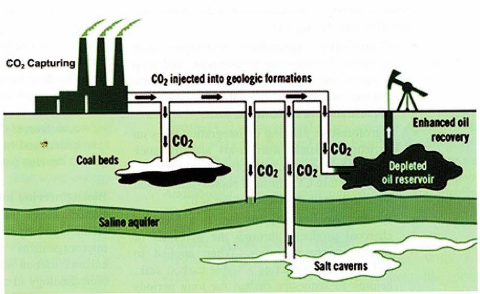
- Natural ecosystems, such as plant-soil biomes, deep ocean biomes, and deep subsurface environments, also contribute to carbon sequestration.
- These ecosystems act as carbon sinks, absorbing CO2 from the atmosphere and storing it for extended periods.
- Harnessing biological systems for carbon capture offers potential long-term storage and climate mitigation pathways.
Biotechnological Innovations in Carbon Capture
- Biotechnology plays a crucial role in advancing carbon capture technologies by enhancing the efficiency of carbon sequestration processes.
- Engineered microbes, carbon-neutral biomaterials, synthetic biology, and genetic engineering of crops are biotechnological approaches used to capture and store CO2 more effectively.
- These innovations offer promising solutions for addressing climate change and reducing greenhouse gas emissions.
Benefits and Challenges of Carbon Capture
- Carbon capture technologies offer numerous benefits, including climate change mitigation, industrial emissions reduction, negative emissions technologies, and job creation.
- However, they also face challenges such as high costs, energy requirements, scalability issues, environmental concerns, and limited applicability to specific sectors.
- Overcoming these challenges requires continued research, development, and investment in carbon capture technologies.
Carbon Pricing and Incentives for Carbon Capture
- Carbon pricing mechanisms, such as carbon taxes and cap-and-trade systems, provide economic incentives for carbon capture and storage.
- By putting a price on carbon emissions, these mechanisms encourage industries to invest in carbon capture projects and reduce their carbon footprint.
- Revenue generated from carbon pricing can offset the costs of implementing carbon capture technologies and drive innovation in the field.
Carbon Capture Projects and Case Studies in India and Around the World
- Petra Nova, United States: Petra Nova is a significant post-combustion carbon capture project in Texas, USA. It operates at the WA Parish power plant and captures CO2 emissions from a coal-fired power plant. The captured CO2 is then utilized for Enhanced Oil Recovery (EOR) and underground storage, showcasing successful integration with EOR techniques.
- Gorgon, Australia: This project in Australia focuses on reducing emissions from natural gas production by capturing and compressing CO2 from gas reservoirs. The captured CO2 is then transported via pipeline for injection and storage in offshore geological formations, demonstrating large-scale industrial application of carbon capture and storage (CCS).
- Sleipner, Norway: The Sleipner field in the North Sea is an early and successful example of CCS, operated by Equinor (formerly Statoil). Since 1996, Sleipner has been capturing CO2 from natural gas production and storing it in a deep saline aquifer, highlighting the long-term viability of CCS in reducing emissions from hydrocarbon production.
- Boundary Dam, Canada: This project integrates post-combustion carbon capture with a coal-fired power plant, making it the world’s first large-scale coal-fired plant with a fully integrated carbon capture system. It captures approximately 90% of CO2 emissions from flue gas and stores it underground, demonstrating the technical feasibility of retrofitting existing power plants with carbon capture technologies.
- Northern Lights, Norway: The Northern Lights project aims to establish a full-scale CCS value chain, including the capture, transport, and storage of CO2. It provides storage capacity for industrial CO2 emissions across Europe and involves the development of infrastructure for large-scale carbon capture and storage across multiple industries and countries.
Carbon Capture Initiatives in India
- ONGC’s CO2 Capture and Utilization: India’s Oil and Natural Gas Corporation (ONGC) has implemented CO2 capture and utilization initiatives at its flagship oil field in Gujarat.
- The captured CO2 is utilized for enhanced oil recovery, increasing oil production while reducing emissions.
- Carbon Capture at Coal-Fired Power Plants: India has initiated pilot projects to explore carbon capture technologies in the coal-fired power sector.
- Supported by the Ministry of Power, these projects aim to capture and store CO2 emissions, reducing emissions in the power sector.
Opportunities for Carbon Capture in India
- While the number of carbon capture projects in India is currently limited, the government’s focus on clean energy and climate action presents opportunities for further development.
- India’s diverse industrial sectors, including steel, cement, and chemicals, offer potential for carbon capture deployment.
- India can move towards a more sustainable and low-carbon future by expanding renewable energy and integrating carbon capture technologies.
Conclusion: Integrated Approach to Climate Mitigation
- While carbon capture is not a standalone solution to climate change, it is an essential component of a comprehensive strategy to achieve carbon neutrality and mitigate the impacts of global warming.
- Integrated with energy efficiency measures, renewable energy adoption, and sustainable practices, carbon capture technologies can help transition to a low-carbon future and ensure environmental sustainability for future generations.
ARTICLE 6: COP28’s CALL ‘Transition away from Fossil Fuels’
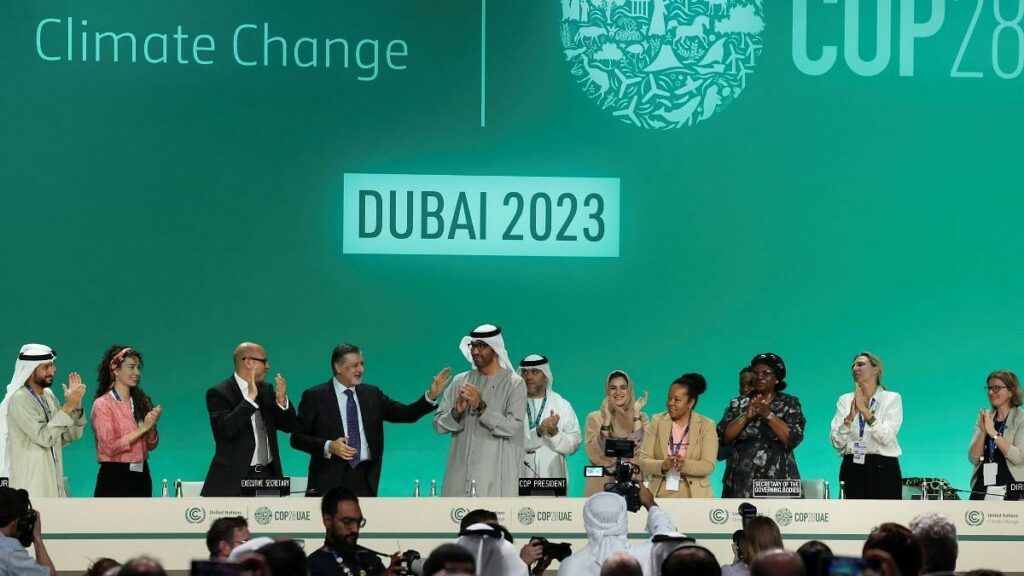
Culmination of COP28 in Dubai
- The 28th session of the Conference of the Parties (COP28) to the United Nations Framework Convention on Climate Change (UNFCCC) convened in Dubai, UAE, advocating for a global transition from fossil fuels.
- This significant event gathered almost 200 countries and over 70,000 delegates worldwide, engaging in discussions and exhibits covering various themes such as health, energy, industry, urbanization, and nature.
- Building upon previous COPs, COP28 emphasized the need for collective action towards a just and sustainable future, echoing the ambition outlined in the Paris Agreement to limit global warming to well below 2°C, preferably 1.5°C.
Global Stocktake (GST) and Climate Analysis
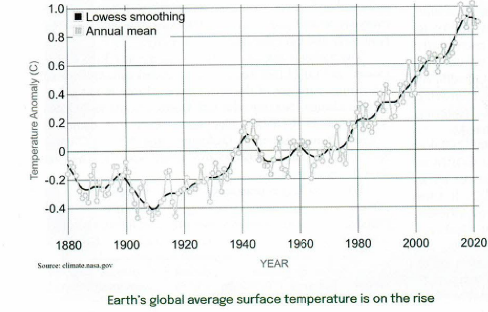
- A key outcome of COP28 was the adoption of the first Global Stocktake (GST) under the Paris Agreement, emphasizing the urgent need for deep, rapid, and sustained reductions in greenhouse gas (GHG) emissions to align with the 1.5°C target.
- The alarming findings of climate analysis reports highlighted the continued warming trend driven by human activities, underscoring the importance of achieving the goals outlined in the Paris Agreement and Sustainable Development Goals (SDGs).
- These reports emphasized the critical role of transitioning from fossil fuels to mitigate the looming climate catastrophe.
Transitioning Away from Fossil Fuels
- COP28 witnessed a landmark deal calling for a just, orderly, and equitable transition away from fossil fuels in energy systems, essential for achieving net zero emissions by 2050.
- The transformative shift towards clean energy futures was evident, with countries pledging to triple renewable energy and double energy efficiency by 2030.
- India, among others, emphasized its commitment to meeting Nationally Determined Contribution (NDC) targets and urged developed nations to facilitate carbon-neutral practices before 2050.
- Furthermore, efforts were made to address the role of food systems, agriculture, and health in climate action, highlighting the interconnectedness of climate change with various sectors.
India’s Contributions and Initiatives
- India’s leadership at COP28 was demonstrated through initiatives like the “Panchamrit” strategy, focusing on ambitious goals for emissions reduction and sustainable living practices.
- Additionally, India co-hosted the Leadership Group for Industry Transition (LeadIT), emphasizing the importance of transitioning industries towards sustainability.
- Collaborative platforms like the Solar Alliance and Coalition for Disaster Resilient Infrastructure (CDRI) underscored India’s commitment to global climate action.
- India’s Green Credit Initiative aimed to incentivize pro-environment actions across various sectors, highlighting the importance of individual and community engagement in achieving environmental sustainability.
Conclusion
- COP28 marked a significant step towards addressing the urgent challenges of climate change, with nations committing to transition away from fossil fuels, accelerating renewable energy adoption, and prioritising health and sustainability.
- India’s leadership and collaborative initiatives underscored the collective effort needed to achieve climate goals and ensure a sustainable future for generations to come.
- Despite challenges, COP28 laid the groundwork for meaningful action towards mitigating climate change and safeguarding the planet.
ARTICLE 7: Climate Change Impact on Agriculture
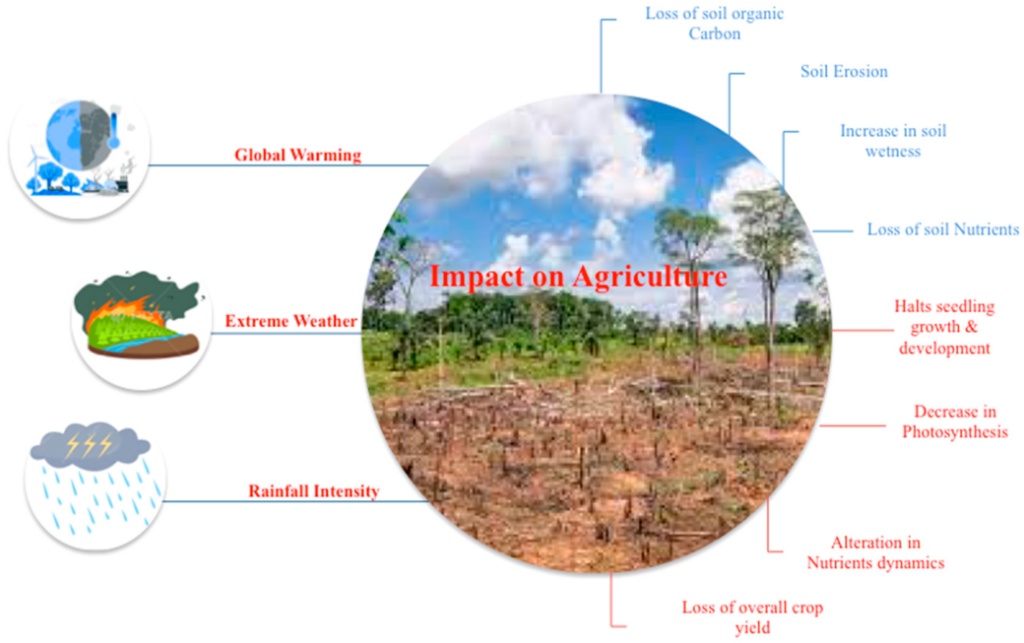
Impact of Climate Change on Food Production
- Climate change poses a significant threat to global food production due to its adverse effects on agricultural systems, which rely heavily on the land, water, and other natural resources.
- Even though the increase in global food production has been substantial, climate change has already started affecting the quantity of food produced worldwide.
- Studies suggest that if greenhouse gas emissions continue unchecked, food production could decline by up to 35% by 2100 due to water scarcity, increased salinity, and topsoil depletion.
Vulnerability of Staple Crops to Climate Change
- Staple crops like wheat and corn are particularly vulnerable to the effects of climate change.
- Wheat, a crucial crop in temperate zones and increasingly demanded in urbanizing countries, faces significant yield reductions with rising temperatures.
- Studies show a linear decrease in wheat production with each degree increase in nighttime temperatures.
- Similarly, corn, the most produced crop globally, is highly susceptible to heat stress, with yields declining with temperatures exceeding certain thresholds, impacting major exporters like the US, Brazil, Argentina, and Ukraine.
Impact on Rice and Other Crops
- Rice, a staple food for billions, also faces challenges as nighttime temperatures affect its yields, with each one-degree Celsius increase leading to a 10% decline during the dry part of the growing season.
- Other crops, like soybeans, experience adverse effects from climate change, including reduced defences against insects due to higher CO2 concentrations.
- Additionally, changing precipitation patterns and warmer temperatures influence plant pollination, disease outbreaks, and pest populations, further threatening crop yields.
Effects of Climate Change on Water Resources
- Climate change intensifies the global water cycle, leading to more intense precipitation events, prolonged droughts, and desertification.
- Increased temperatures accelerate evaporation rates, exacerbating water shortages and drought conditions.
- Groundwater depletion, soil erosion, and reduced soil moisture further impact agricultural productivity. Consequently, extreme weather events and water scarcity disrupt crop growth and food production, with profound economic and environmental consequences.
International Cooperation and the Path Forward
- Addressing climate change and its impacts on food production requires global cooperation and a paradigm shift in thinking.
- Oblivious to political boundaries, greenhouse gases necessitate collaborative efforts among nations to mitigate their effects and safeguard the planet for future generations.
- As climate change threatens food security and environmental sustainability, concerted action and innovative solutions are imperative to ensure a better future for humanity.
ARTICLE 8: Science Diplomacy: A New Paradigm in the Post-Truth World
Introduction and Context:
- In the discourse on global challenges and international cooperation, the concept of science diplomacy has emerged as a crucial tool for addressing complex issues that transcend national boundaries.
- As humanity grapples with pressing concerns such as climate change, nuclear proliferation, and misinformation, the need for collaborative efforts guided by scientific expertise has become increasingly evident.
- Against this backdrop, understanding the role and potential of science diplomacy is essential in shaping a more sustainable and harmonious world.
Global Challenges and the Role of Science Diplomacy
- Highlighting the myriad global challenges humanity faces, the article emphasizes the pivotal role of science diplomacy in addressing these issues.
- From climate change to nuclear disarmament and the proliferation of fake news, these problems necessitate international cooperation and scientific collaboration.
- The article underscores the importance of leveraging scientific partnerships to find optimal solutions and foster global harmony.
Science Diplomacy: A Tool for Conflict Resolution and International Cooperation
- The concept of science diplomacy is explored further, illustrating its potential in conflict resolution and governance of international spaces.
- Drawing from personal experiences as an expedition scientist in Antarctica, the article’s author illustrates how scientific research transcends national borders, fostering peaceful cooperation in regions like Antarctica.
- The Antarctic Treaty System serves as a model for international collaboration, emphasizing the role of science in maintaining global stability.
Premises and Initiatives in Science Diplomacy: The Indian Perspective
- The three basic premises of science diplomacy — science in diplomacy, diplomacy for science, and science for diplomacy — are outlined, highlighting its multifaceted nature.
- The article discusses initiatives in India to promote science diplomacy, including establishing research centres and training programs.
- Examples such as the Indo-US civil nuclear deal underscore India’s engagement in science diplomacy and its potential to transform geopolitical relationships.
The Role of National Science Academies and Youth Engagement
- The role of national science academies in promoting science diplomacy is underscored, particularly in engaging with the public and fostering international collaborations.
- Initiatives like the Indian National Young Academy of Sciences (INYAS) highlight the importance of engaging young scientists in policy-making and international cooperation.
- The article stresses the need for greater involvement of young scientists in shaping science diplomacy efforts, ultimately bridging nations through scientific collaboration.
ARTICLE 9: National Quantum Mission
India’s Technological Achievements:
- India has made significant strides in the fields of science and technology, which is evident from accomplishments such as the establishment of the National Research Foundation and landmark space exploration missions like Mangalyaan, Chandrayaan, Aditya L1, and Gaganyaan.
- These achievements have showcased India’s prowess in scientific and technological endeavours on the global stage, positioning it among the select few countries with notable accomplishments in these domains.
National Quantum Mission (NQM):
- The Indian government, under the leadership of Prime Minister Shri Narendra Modi, has approved the National Quantum Mission (NQM) with a total allocation of Rs 6003.65 crore.
- The mission aims to advance Quantum Technologies & Applications (QTA). It includes objectives such as developing intermediate-level quantum computers, satellite-based secure quantum communications, and designing quantum materials and devices.
Mission Objectives and Implementation:
- The NQM aims to develop intermediate-level quantum computers with 50-1000 physical qubits, establish satellite-based secure quantum communications, and create high-sensitivity magnetometers, among other goals.
- Implementation involves setting up Thematic Hubs (T-Hubs) in top academic and National R&D institutes focusing on various domains of quantum technology such as computing, communication, sensing, and materials.
Potential Impact and Benefits:
- The NQM has the potential to enhance India’s technological development system to compete globally.
- It is expected to benefit various sectors, including communication, health, finance, and energy, with applications ranging from drug design to space exploration.
- Additionally, the mission aligns with national priorities like Digital India, Make in India, Skill India, and Sustainable Development Goals (SDG), further bolstering India’s pursuit of self-reliance and innovation.
ARTICLE 10: LOVE: Unravelling the Biochemistry behind it
The Complexity of Love:
- Common sayings like “Everything is fair in love and war” and “Love is blind” reflect love’s puzzling and multifaceted nature.
- Contrary to popular belief, love isn’t solely about romantic gestures or the beating heart; it’s a complex behavioural expression intensely regulated by the brain rather than the heart.
Biological Basis of Love:
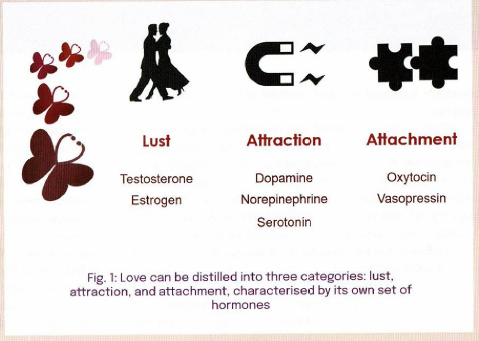
- Love is primarily a behavioural pattern controlled by the brain, specifically by regions such as the limbic system, pituitary, and prefrontal cortex.
- The heart merely reacts to the brain’s signals. Understanding this, failed love experiences can be attributed to brain activity rather than heartbreak.
Differentiating Love from Attraction and Lust:
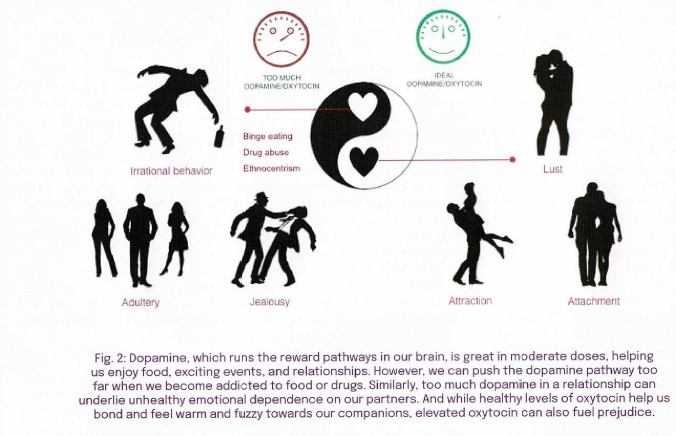
- Attraction, attachment, and lust are distinct patterns of behaviour associated with love, each governed by different brain areas and hormones.
- Attraction, driven by dopamine, is characterized by heightened emotions and decreased serotonin levels.
- Lust, fueled by testosterone and estrogen, focuses on sexual desire.
The Role of Hormones:
- Oxytocin and vasopressin play critical roles in long-term attachment, fostering behaviours such as bonding between partners, parents and children, and even owners and pets.
- However, excessive levels of hormones like dopamine and oxytocin can lead to irrational behaviour akin to addiction.
Evolutionary Perspective:
- Love has deep evolutionary roots, with social behaviour and emotional bonding essential for survival and species propagation.
- Brain areas controlling emotions evolved before those for critical thinking, leading to discrepancies between emotional impulses and rational interpretations.
Epigenetic Regulation of Love:
- Love is epigenetically regulated by genes associated with hormone production, with prenatal and postnatal experiences shaping individuals’ behavioural patterns.
- Exposure to stress during pregnancy, for example, can influence offspring’s reactions to fear and anxiety.
Coping with Love’s Consequences:
- While love brings emotional fulfilment, its loss can lead to stress and heartbreak.
- However, the body’s hormonal network, including oxytocin, helps combat stress and aids in emotional recovery.
Future of Love Research:
- Despite significant study, many aspects of love remain unanswered. Understanding love’s complexities is crucial for fostering social bonds and individual interactions essential for ecosystems.
- Continued research will uncover more mysteries, enhancing our understanding of this enigmatic phenomenon and its profound impact on human behaviour and society.
ARTICLE 11: Prime Editing Towards More Precise, Targeted Genome Editing
Advancements in Crop Breeding:
- In recent years, significant progress has been made in developing crop varieties resilient to changing climatic conditions through scientific experimentation and the use of Next-Generation Sequencing (NGS) technology.
- This technology allows for precise and faster breeding processes by targeting specific regions in the genome for gene modification.
CRISPR-Cas9 and Prime Editing:
- The development of the CRISPR-Cas9 system revolutionized genetic modification by enabling precise genome editing.
- However, a recent advancement called ‘Prime Editing’ offers even greater precision by allowing targeted editing without causing double-stranded DNA breaks.
- Prime Editing has shown efficacy comparable to CRISPR-Cas9 but with fewer off-target effects, making it a promising tool for genetic improvement.
Components and Applications of Prime Editing:
- Prime Editing relies on guide RNA (pegRNA) and a fusion protein consisting of a Cas9 nickase and reverse transcriptase.
- This technology has been successfully applied in plants, allowing for the creation of herbicide-tolerant rice plants and edits in rice and wheat genes.
- The versatility of prime editing offers new opportunities for precision crop breeding, particularly for enhancing tolerance to both biotic and abiotic stresses.
Future Prospects for Climate-Resilient Crops:
- Prime editing holds immense potential for developing climate-resilient crops by precisely targeting genes associated with disease resistance and stress tolerance.
- By introducing specific mutations or altering regulatory elements in the genome, prime editing can speed up the evolutionary process of crop domestication and develop novel drought and salinity-tolerant varieties.
Conclusion:
- The advancements in genome editing technologies, particularly prime editing, offer unprecedented opportunities for precision crop breeding.
- By harnessing the power of these tools, researchers can address the challenges posed by climate change and develop crops that are better adapted to the evolving environmental conditions, ensuring food security for future generations.
ARTICLE 12: Lake Natron: Tanzania’s Hyper Saline Red Lake

- Lake Natron is renowned for its extreme salinity, making it deadly for most organisms.
- Located in the Ngorongoro District of Tanzania, its hypersalinity gives it a deep red colour, attracting unique organisms like cyanobacteria.
- Trona (sodium sesquicarbonate dihydrate) and natron (hydrated sodium carbonate) deposits make their waters highly alkaline, with temperatures ranging from 40 to 60°C and a pH above 12.
- Animals not adapted to its acidic nature can experience skin burns when exposed to its water.
- Despite its harsh conditions, Lake Natron serves as a breeding ground for lesser flamingos, attracting them with blue-green algae, their primary food source.
- Other bird species have also adapted to their environment. While deadly to many, its unique ecosystem and stunning views make it a paradise for photographers.
NEWS IN BRIEF
1) Sensor for Rapid Water Quality Monitoring
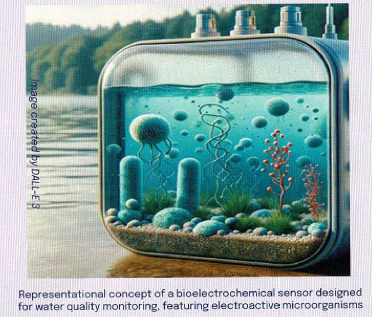
- Researchers from IIT Delhi’s Department of Biochemical Engineering and Biotechnology have developed a sensor for real-time water quality monitoring using electricity-generating microorganisms, known as “electroactive microorganisms.”
- These microbes produce electrical current and are typically studied for power generation but can also be utilized for biosensing purposes. The sensor employs “weak electricigen,” a type of electroactive microbe that generates low levels of electricity.
- When these weak electricigens encounter pollutants, their current output decreases. The sensor enables real-time water quality monitoring by continuously measuring their extracellular current.
- This technology could serve as an early-warning system, complementing conventional monitoring methods that may be costly or unsuitable for continuous operation.
- The research paper detailing this development was published in ACS Applied Bio Materials.
2) Virtual Reality Goggles for Mice

- Researchers from Northwestern University have developed new Virtual Reality (VR) goggles for mice known as Miniature Rodent Stereo Illumination VR (iMRSIV).
- These miniature goggles aim to provide more immersive experiences for mice in laboratory settings, allowing for the more accurate study of the neural circuitry underlying behaviour by simulating natural environments more faithfully.
- The goggles enable researchers to simulate overhead threats, a capability previously unavailable with existing systems.
- The iMRSIV system consists of two lenses and two screens, one for each side of the mouse’s head, to separately illuminate each eye for 3D vision, providing a 180-degree field-of-view for each eye.
- This immersive setup excludes the surrounding environment. The research detailing this advancement was published in the journal Neuron.
3) New Al noise-cancelling headphone
- Researchers at the University of Washington have created deep-learning algorithms for real-time noise filtering using headphones, termed “semantic hearing.”
- This system allows users to selectively choose the sounds they want to hear through their headphones while blocking unwanted noise.
- Using smartphones, users can cancel environmental sounds using an app or voice command and then choose specific sounds they wish to include, which will be played through their headphones.
4) New Conductive, Cotton-based Fiber for Smart Textiles
- Researchers at Washington State University have created a single strand of fibre combining cotton’s flexibility with the electrical conductivity of a polyaniline polymer.
- This innovative material holds promise for wearable e-textiles. The fibres demonstrated potential applications in wearable technology when tested with systems powering LED lights and sensing ammonia gas.
- The researchers envision integrating such fibres into apparel as sensor patches with flexible circuits, which would be beneficial for firefighters, soldiers, or chemical workers to detect hazardous exposures.
- Other potential applications include health monitoring and exercise shirts with advanced functionalities beyond current fitness monitors.

